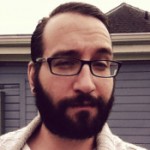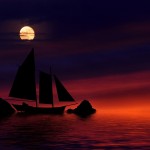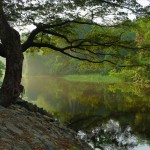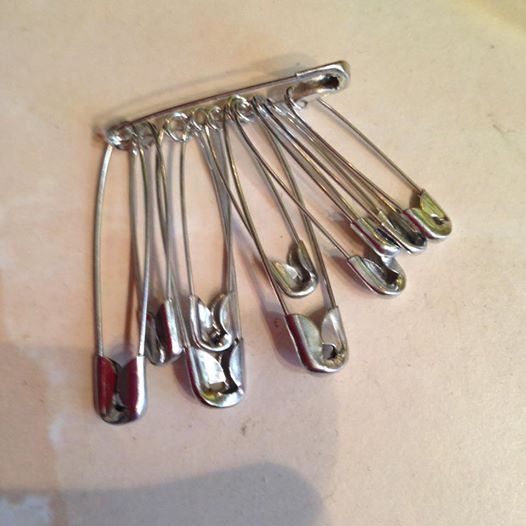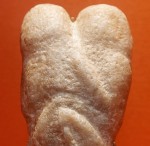It’s my birthday month, and I’m sorry to say I got a crown.
Not a sparkly one from some kid-friendly chain restaurant. Not a crown of branches or horns from a Neo-Pagan ceremony. No, I won one of those plastic, temporary tops for a cracked tooth that will soon enough be replaced by porcelain.
Happy Birthday. Feeling older, much?
I should have taken a page out of your book, Wayland, lord, and asked
if the dentist would carve me a tooth out of bone.
***
So I’m feeling a little vulnerable, tonight. Aware of my body, more than I usually am, and its tender places, its wounds and scars. This is probably doubly true because I just started a shapeshifting class at Cherry Hill Seminary. Here are the very first sentences of the very first reading assignment:
Owning up to being an animal, a creature of earth. Tuning our animal senses to the sensible terrain: blending our skin with the rain-rippled surface of rivers, mingling our ears with the thunder and the thrumming of frogs, and our eyes with the molten sky. Feeling the polyrhythmic pulse of this place—this huge windswept body of water and stone. This vexed being in whose flesh we’re entangled.
From Becoming Animal, David Abram
What does that mean? What is “shapeshifting” anyway? my friends ask me. For me, the concept of shapeshifting offers (I hope) a way to enter the experience(s) of world more deeply, more fluidly. I’ve been looking forward to the start of class for weeks. But after the first Google+ chat session, I feel more trepidation than anything. The teacher emphasized what a personal journey this is going to be for us.
It’s clear that in order to learn how to move even an inch or a minute away from the usual mundane experience, I’ll have to become a little (or a lot) vulnerable. The adult layers of defense and protection I worked so hard to create? Peeled away.
Shields down, friends. It’s about to get real.
***
For years, no matter what term/s I called myself—poet, theologian, at-home-parent-trying-to-survive, polytheist, or (as I used to say in a whisper) just a vague-ish pagan-ish sort—my practice has been pretty much the same: a shifting triangulation between historical source/text, poetry, and myth. With this class, it looks like NATURE may be about to assert itself as the fourth leg of that practice. That includes (especially) my own human animal nature, bag of skin and muscle and bone, hair and bacteria. I welcome that. And I fear it too, a little. Abram knows this:
Corporeal life is indeed difficult. To identify with the sheer physicality of one’s flesh may well seem lunatic. The body is an imperfect and breakable entity vulnerable to a thousand and one insults…Small wonder then that we prefer to abstract ourselves whenever we can, imagining ourselves into theoretical spaces less fraught with insecurity, conjuring dimensions more amenable to calculation and control…
It’s completely appropriate and serendipitous that we’re also just back from our annual camping trip up on Madeline Island, in Lake Superior. I have some coastal friends who scoff at the idea of the Great Lakes—it’s not the ocean, they say with a shrug of a shoulder. Of course not. The ocean is endless, absolute.
The Great Lakes are something else again—interior seas. And so they fit differently into the psyche. There have been a couple of blog posts I’ve seen, here and here, in which the authors map out their spiritual geographies. I find the idea fascinating—and I tried it one night with my crayons and sketchpad. It’s not finished yet, but already off to one side, there’s a lake. A large one. When I stepped into the waters of Lake Superior, I recognized the sensation exactly. I’ve swum here before.
Remember when we pitched our tents,
young as we were, above Superior’s gray shore,
and discovered there a steep path to the back
we hadn’t seen before?
On my own map, it’s labeled the Lake of Sorrows, and there have been times when I have had to swim it, ready or no. Maybe someday I’ll write about that. About the temptation to stay there, in the water. Under the water. It was one chapter of a longer journey. Maybe someday I’ll write the rest.
 It was a journey of healing, after a wounding of my own that was a little more serious than a cracked molar. And it’s important to tell our stories, to ourselves and others. But today I wonder—when I move in this essay from Lake Superior itself to my Lake of Sorrows, am I merely imagining myself into one of Abram’s “theoretical spaces less fraught with insecurity”? I’m willing to consider the possibility, although admittedly nothing about swimming that interior Lake feels “more amenable to calculation and control.” Not at all.
It was a journey of healing, after a wounding of my own that was a little more serious than a cracked molar. And it’s important to tell our stories, to ourselves and others. But today I wonder—when I move in this essay from Lake Superior itself to my Lake of Sorrows, am I merely imagining myself into one of Abram’s “theoretical spaces less fraught with insecurity”? I’m willing to consider the possibility, although admittedly nothing about swimming that interior Lake feels “more amenable to calculation and control.” Not at all.
Here there be dragons.
You aren’t kidding.
***
Shapeshifting is partly about knowing yourself intimately, and all your wounds and weaknesses. In the Northern pantheon that I am learning about, woundedness is a common theme. These gods are for the most part not young and beautiful—they have their scars. I’m far from an expert in the lore but off the top of my head: Tyr gives up a hand to bind Fenrir, the wolf that represents Chaos. Sif’s beautiful hair is hacked off (and we all know what that represents, right?). Both Frigga and Sigyn lose their children. Sigyn is burned, scarred by the poison she protects her husband Loki from. Odin the Allfather sacrifices an eye for wisdom, hangs himself for nine days in order to win the runes. And Wayland the Smith is hobbled, and held captive for years.
He looks at the pictures of Lake Superior on my computer screen.
We call it the Quench.
Lake Superior?
Shaking his head. Water. We use water to quench
the hot blade. That is the moment of testing, to see
if what we made will be true, or if it will torque, twist, corrupt.
***
Any blessing carries its shadow, sometimes for years,
folded like the wings of a bat at noon.
How grateful I am, friends, for that shared memory,
now that I have reached another interior shore,
this time alone, and again to strip down…
We all have our scars and wounds, not all of them visible. Not even remembered, some of them, maybe, until that sudden plunge into a new element. Wish me luck.
Don’t trust to luck.
**
Notes and References
The whole poem, “Youth Was Armor Enough” can be found here.
Abram, D. (2010). Becoming Animal. New York, NY: Random House (Vintage)


